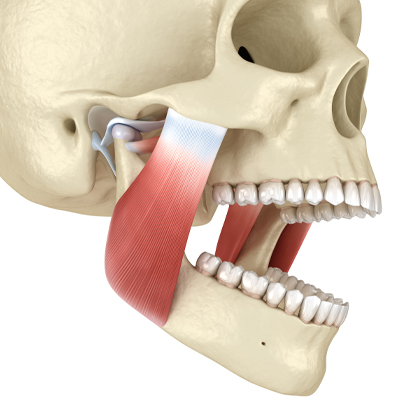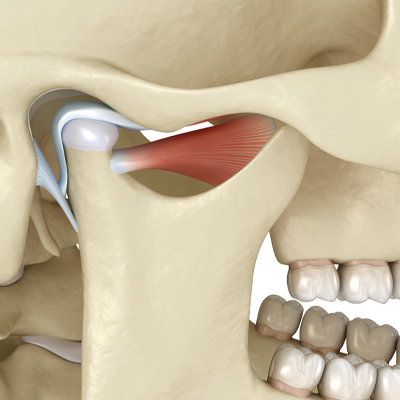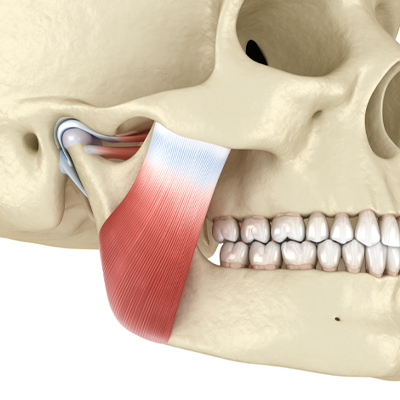TMJ Treatment
Are you often experiencing jaw pain, migraines, and headaches?
It may be connected to your jaw joint or the temporomandibular joint (TMJ). The TMJ connects the lower jaw to the skull. It allows us to open and close our mouths, speak, and eat.
Issues involving the jaw joint are referred to as TMJ disorders or TMD. They can result in facial pain and difficulties when moving your jaw. The exact causes of TMD are still unclear, but a wide range of factors can trigger it. TMD is treatable, but the process can be challenging as there are several possible causes. Common causes include injury or trauma to the area, teeth grinding or clenching, and jaw erosion.
TMJ Disorder Symptoms
Here are some of the common symptoms of TMJ disorders:

Headaches And Migraines
The jaw joint system crosses the jaw and cheeks, so any discomfort in this area can cause headaches. When the jaw muscles are stressed and leads to teeth grinding, the pain can reach your cheeks and head, and trigger headaches.

Jaw Pain, Clicking, and Locking
One common symptom of TMD is the clicking, grinding, or popping sound when you’re opening and closing your mouth or are speaking or eating. Note, however, that unusual sounds alone aren’t usually a sign of TMJ disorders.

Facial Pain And Ear Pain
Pain when using the jaw or that which radiates to your head and back is also another common TMD symptom. Your dentist can check where the pain is coming from to verify if it’s connected to the jaw joint.
TMJ Disorder Symptoms
Here are some of the common symptoms of TMJ disorders:

Headaches And Migraines
The jaw joint system crosses the jaw and cheeks, so any discomfort in this area can cause headaches. When the jaw muscles are stressed and leads to teeth grinding, the pain can reach your cheeks and head, and trigger headaches.

Jaw Pain, Clicking, and Locking
One common symptom of TMD is the clicking, grinding, or popping sound when you’re opening and closing your mouth or are speaking or eating. Note, however, that unusual sounds alone aren’t usually a sign of TMJ disorders.

Facial Pain And Ear Pain
Pain when using the jaw or that which radiates to your head and back is also another common TMD symptom. Your dentist can check where the pain is coming from to verify if it’s connected to the jaw joint.
TMD Diagnosis and Home Remedies
Your dentist can help assess and diagnose your condition. Dental professionals are experts in facial anatomy. They can examine your mouth, jaw area, and related structures and check for symptoms of TMJ.
There’s no single test for diagnosing TMD. A CT scan or MRI of your jaw may be required to check the bones, tissues, and jaw structure. While you’re waiting to see the dentist, you may also try the following to help relieve TMJ symptoms:
- Apply ice or warm packs on the area to reduce swelling or discomfort.
- Avoid too much jaw movement or strenuous physical activities.
- Switch to a soft food diet that doesn't require heavy chewing.
- Manage stress and use relaxation techniques, such as meditation.
- Check out exercises to help improve jaw mobility.
- Beware of potentially harmful habits such as opening packages using your mouth or biting down on hard objects.
- Be more mindful of your posture when sitting in front of the computer for a long period.
- Take over-the-counter pain medications to ease discomfort. Be sure to follow the recommended dosage.
Learn more about TMJ and TMD treatments in SE Calgary
Don’t ignore discomfort in your jaw area. Talk to your dentist if you’re noticing any irregularities or if the pain still continues even after you’ve tried home remedies.
TMD may not be serious, but in some instances, it may require corrective procedures or surgeries. If you’re looking for a TMJ assessment in SE Calgary, contact us at Mckenzie Towne Family Dental today at (403) 257-1180. Our friendly receptionists are happy to help you book an appointment with one of our General Dentists. New patients, children or adults, are welcome.

Whether it's a dental emergency in South Calgary or just a regular checkup or cleaning, McKenzie Towne Dental wants to make your experience as comfortable and convenient as possible. Serving McKenzie Towne, Cranston, Auburn Bay, Seton, Copperfield, New Brighton, Mahogany, Inverness, and all of Southeast Calgary
© Copyright 2025 McKenzie Towne Family Dental and Dental Growth Strategies | All Rights Reserved | Powered by Dental Growth Strategies | Disclaimer: Dr. Safi Magharius is a general dentist, not a cosmetic dental specialist. Cosmetic dentistry is not a term/specialty recognized by the Alberta Dental Association & College (ADA&C). Dr. Magharius provides cosmetic dental procedures such as porcelain veneers, dental implant crowns, dental bonding, and teeth whitening as part of his general dentist license.